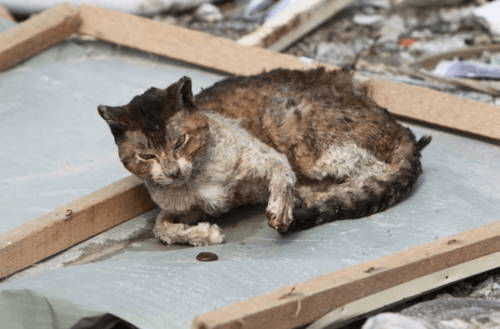|
|

Environmental and societal catastrophes are unfortunate but undeniable occurrences. Floods, fires, storms, and power outages can affect entire families — including feline companions. Owners have a responsibility to enact measures of disaster preparedness for cats. These include plans for before and during an emergency. Cats depend entirely on the care of their owners especially in the wake of devastation, and thorough precautions can be life-saving. This comprehensive guide will give you the tools you need to prepare for any unwanted disaster.

As a cat owner you are probably already aware of the quirky, independent trademark behavior of the feline kind. Differentiating hugely from dogs, cats tend to behave on their own terms. This includes showing affection, using the bathroom, eating, drinking, and deferring to their owners. While cat lovers have come to accept and embrace these characteristics, non-compliant behavior can have adverse effects in times of disaster.
A cat’s sensitivity to stress is higher than most domesticated species. Environmental changes combined with overwhelming human emotions breeds feline fear. A cat’s typical reaction to fear is to run and hide in small places in order to protect themselves. This behavior can make safely collecting a cat difficult in times of emergency. While an event’s physical outcomes cannot be avoided, there are strategies to mitigate the feline fear factor when managing disaster preparedness for cats.
1) Analyze your cat’s reactive behavior patterns in advance. Monitor them during thunderstorms, when new people enter the household, or through any other fear-triggering situation. Take mental notes of their flight routes and favorite hiding spots.
2) Avoid exposure to impossible retrieval points — i.e. holes to crawl spaces, unused basement space, vent ducts, cluttered garages, ect. It is important to be able to locate your cat during an emergency.
3) Create desirable safety environments to encourage your cat’s selection of hiding places. For example, leave an open carrier tucked away in the corner of your feline’s favorite room. Routinely place treats, toys, or catnip in the carrier. The safe, confined space and food enticement may insight a cat’s habitual selection of your chosen hiding place. In addition, finding your pet already in their carrier when disaster strikes is hugely beneficial.
4) Remain calm and move slowly. Although human emotions tend to spike during stressful situations, it is important not to impart these feelings upon your cat. They are sensitive to your perceptions therefore it is crucial to act coolly. Deep breathing, reassurance, and consciously slowing your movements during an emergency can help decrease your cat’s anxiety.
The most logical way to manage a disaster is to have protocols set in place before the event takes place. Develop a plan in advance and make sure it is understood by the whole family. Outline methods to handle a variety of different disaster possibilities. Tailor them to each individual family member’s needs — including your cat. Although unlikely, be prepared for the worst.
1) Identify your cat. While being able to retrieve your pet during an emergency is the most ideal outcome, it is possible they may escape or be separated. In this event, it is important for your cat to have proper identification in order to be located and returned to you. Optimal identification includes a pet ID tag with the owner’s name and phone number etched on the back as well as a registered microchip in case your cat loses their collar. Rescue organizations and veterinary hospitals have the ability to read microchips and immediately connect animals to their owners.
2) Keep your cat up to date on vaccinations. Although your indoor cat may unlikely be exposed to rabies, feline leukemia, herpes, or distemper, it is important for your pet to be vaccinated in the event of contact with outside animals during a disaster.
3) Take photos and keep them handy. Whether on your smart phone or stored in a safe place, photos of your cat will be immensely helpful to show to neighbors, shelters, and emergency personnel in the event of a separation. If your cat loses their collar and falls into the care of someone without the ability to read a microchip, photos of your cat will be your best asset.
4) Ensure animal awareness. Having a sticker on your window identifying the number of family members and pets inside provides imperative information to the authorities in the event of a necessary rescue. Informing your neighbors you own a cat is also useful.
5) Prepare for the possibility of an evacuation. A few helpful tips: keep your gas tank full, have a pet carrier on hand, and maintain a list of phone numbers and addresses of safe places for your cat to go. This list can include shelters, nearby boarding facilities, veterinary hospitals, pet-friendly public accommodations, or other family members’ homes.
A bad storm, power outage, tornado, or other unstable outside conditions may require long or short-term relocation to a safe place within your own house or other location. While emergency supplies for humans are often easily accessible, your feline companions have drastically different needs. Cats must be accommodated accordingly in order to ensure their health and livelihood during a disaster. Stocking up on emergency supplies in advance is critical.
1) Fresh Food — Keeping a weeklong supply of your cat’s normal nibbles on hand ensures proper nutrition and an increased likelihood your pet will want to eat under duress. Canned food is preferred due to its greater storage longevity compared to bags of dry food. Small pop top cans are ideal for ease and possible lack of refrigeration options. If dry food is necessary, be sure to keep it in an airtight container with a locking lid.
2) Water — Necessary for the livelihood of both pets and owners, having enough clean drinking water available for the entire family is essential. Plastic storage containers are cheap to purchase and easy to store. Including water purifying tablets in your emergency supply kit is a good idea as well.
3) Cat Bathroom — In order to maintain a familiar and comfortable environment for your cat, keep an accessible emergency litter box, scoop, and weeklong supply of litter nearby.
4) Means of Restraint — A cat carrier is crucial for safe transportation and confinement. A harness and leash are additional tools that can be used to allow your pet to exercise outside of their carrier without risking escape. Keeping a towel on hand is recommended as well in order to collect a possibly fractious or fearful feline.
5) Health Requirements — If your cat is on any form of long-term medication, keeping a weeklong supply on hand is helpful in case of an emergency. Talk with your vet about your concern. Most veterinarians will have no objections to filling an emergency supply script and more than likely will commend your utilization of disaster preparedness for cats. Copies of your pet’s veterinary records are also helpful for proof of vaccinations and providing crucial medical history to rescues or shelters.
6) Basic First Aid — In the event your cat is injured and in need of veterinary care, having a few basic first aid supplies on hand can be useful. Latex gloves, diluted betadine for cleaning wounds, gauze pads, and pressure wraps can be safely used while seeking proper veterinary care.
7) Comfort Items — Emergency situations will undoubtedly stress your sensitive cat, therefore it is important to provide a familiar, stable environment. Having toys, treats, small scratching boards, or other desirable items on hand can help manage your cat’s anxiety through a disaster.
Catastrophes are unwanted occurrences but being prepared can help lower the stress and seriousness of any situation. This especially applies to your beloved feline companions, and on account of their unique needs, disaster preparedness for cats is essential. Never fear for your feline friend again! No cat should be left behind.
Tag
Tag